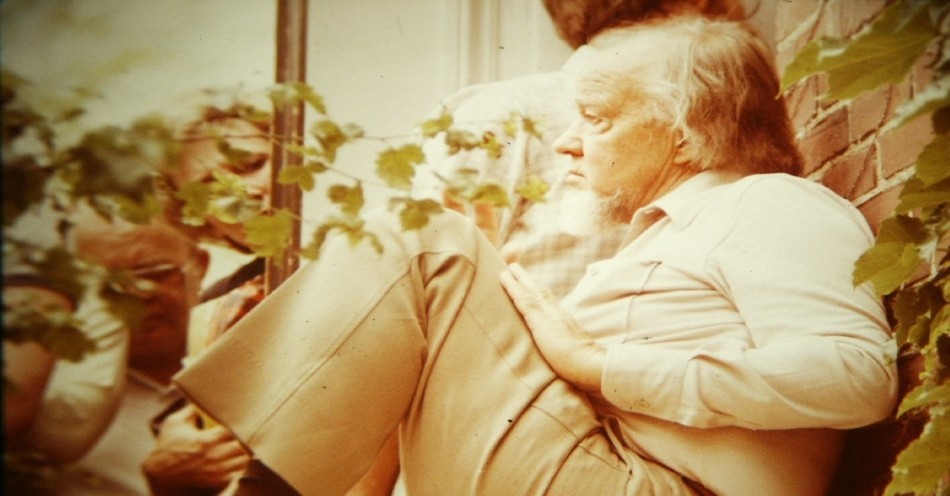For evangelical Christians in the 1960s-1970s, Francis Schaeffer’s teachings came like a thunderbolt. He analyzed existentialism and other popular philosophies, arguing that only Christianity had the necessary foundation for a consistent life that answered humanity’s deep longings. He argued Christians needed to take creativity seriously, talking about Frederico Fellini when many Christian colleges wouldn’t let students see To Kill A Mockingbird. Two generations later, his work continues to be a landmark example of combining faith, wisdom and holistic living.
Here is what you need to know about this original Christian thinker.
10 Important Events in the Life of Francis Schaeffer
1. On January 30, 1912, Francis August Schaeffer IV was born in Pennsylvania to Francis August Schaeffer III and Bessie Williamson. The drunk doctor neglected to fill out a birth certificate, which Schaeffer did not discover until he was 35 years old.
2. On August 19, 1930, after reading the Bible cover to cover, Schaeffer attended an evangelist tent meeting where he accepted the altar call to give his life to Christ.
3. On July 26, 1935, Schaeffer married Edith Seville, a daughter of missionaries who worked in China. Many have stated Edith was integral to her husband’s life and ministry, with Schaeffer’s student Os Guinness saying, “In many ways, she was the secret of L’Abri.”
4. In 1938, Schaeffer graduated from Faith Theological Seminary, one of its first graduates. He then became the first pastor ordained in the Bible Presbyterian Church, which split from the Presbyterian Church of America in 1937. He would serve as a pastor for 10 years, participating in many fundamentalist-liberal discussions.
5. In 1945, while living in St. Louis, the Schaeffers started Children for Christ. These credentials led to the Schaeffers becoming better known in Presbyterian circles, particularly the Independent Board for Presbyterian Foreign Missions.
6. In 1948, the Schaeffer family moved to Europe, representing the Independent Board for Presbyterian Foreign Missions and helping with an Amsterdam conference that formed the International Council of Christian Churches. During this trip, he met Dutch art critic Hans Rookmaaker, who became one of his greatest friends.
7. In 1955, after several years of European missionary work with the International Council of Christian Churches, Schaeffer resigned to start L’Abri Fellowship in Huemoz, Switzerland.
8. In 1965, Schaeffer did a lecture tour across the United States. Wheaton Bible College audiences asked for print copies of his lecture, inspiring Schaeffer to reshape his material into published books.
9. In 1978, Schaeffer began treatment at the Mayo Clinic for lymphoma. His cancer went into remission, but he acquired a home in Rochester, Minnesota, to get periodic treatments at the clinic. The Rochester home evolved into a L’Abri Fellowship that continues to this day.
10. On May 15, 1984, Schaeffer died in Rochester, Minnesota. Memorial services took place in Rochester and All Souls Church, Langham Place, London. Os Guinness spoke at the London Service, observing that the greatest thing about Francis Schaeffer wasn’t his books or methods: “the greatest thing about Francis Schaeffer was Francis Schaeffer.”
10 Important Quotes by Francis Schaeffer
1. “The lordship of Christ over the whole of life means that there are no platonic areas in Christianity, no dichotomy or hierarchy between the body and soul. God made the body as well as the soul and redemption is for the whole man. Evangelicals have been legitimately criticized for often being so tremendously interested in seeing souls get saved and go to heaven that they have not cared much about the whole man.”—Art and the Bible
2. “This [debate] is not a game I am playing. If I begin to enjoy it as a kind of intellectual exercise, then I am cruel and can expect no real spiritual results. As I push the man off his false balance, he must be able to feel that I care for him. Otherwise I will only end up destroying him, and the cruelty and the ugliness of it all will destroy me as well.”—The God Who Is There
3. “Every generation of Christianity has this problem of learning how to speak meaningfully to its own age.”—Escape from Reason
4. “In this life I can never say, ‘I have arrived; it is finished; look at me—I am holy.’”—True Spirituality
5. “Christians have tended to despise the concept of philosophy. This has been one of the weaknesses of evangelical, orthodox Christianity—we have been proud in despising philosophy, and we have been exceedingly proud in despising the intellectual.”—He Is There and He Is Not Silent
6. “The Christian does not say that there is no chemical or psychological conditioning. Some may argue that way, but they are trapped because chemical psychological conditioning can be demonstrated. My height was determined at conception by the chemical properties of my genes. Many aspects of my physical make-up were conditioned by heredity. But to a Christian, though man may undergo a good deal of conditioning, he is not only the product of conditioning. Man has a mind: he exists as an ego, an entity standing over against the machine-like part of his being.”—Back to Freedom and Dignity
7. “I want to add here that evangelicals have made a horrible mistake by often equating the fact that man is lost and under God’s judgment with the idea that man is nothing—a zero. This is not what the Bible says. There is something great about man, and we have lost perhaps our greatest opportunity of evangelism in this generation by not insisting that it is the Bible that explains why man is great.”—He Is There and He Is Not Silent
8. “We can talk about methods, we can stir each other up, we can call each other to all kinds of action, but unless it is rooted in a strong Christian base in the area of content and the practice of truth, we build on sand and add to the confusion of our day.”—Two Contents: Two Realities
9. “Holding to a strong view of Scripture or not holding to it is the watershed of the evangelical world.”—No Final Conflict
10. “People are unique in the inner life of the mind—what they are in their thought-world determines how they act. This is true of their value systems and it is true of their creativity. It is true of their corporate actions, such as political decisions, and it is true of their personal lives. The results of their thought-world flow through their fingers or from their tongues into the external world. This is true of Michelangelo’s chisel, and it is true of a dictator’s sword.”—How Should We Then Live?
10 Things You Probably Didn’t Know about Francis Schaeffer
1. He didn’t do it alone. While Edith Schaeffer wasn’t the public face of L’Abri, she was equally important. She helped manage the center, wrote the first book about the founding of L’Abri, and released a newsletter that reached over 1,000 readers. She also wrote several landmark books on homemaking as an artistic, Christian practice.
2. He wasn’t a classic intellectual. Unlike many famous theologians, Schaeffer didn’t come from a highly educated family that loved books. After the third grade, his father stopped school to support his family and later worked as a sailor and caretaker. Schaeffer scored high on school intelligence tests but focused on trade classes. His father’s belief that all pastors were parasites living off others created a problem as Schaeffer felt a call to ministry.
3. He had struggles. Schaeffer confidently talked about religion and the Bible but didn’t pretend faith made life easy. Biographer Colin Duriez (a Li’Abri student in the 1970s) describes Schaeffer’s lifelong struggles with dyslexia and his temper and bouts of depression. Duriez observes that Schaeffer openly admitted his imperfections, showing that a spiritual teacher didn’t have to be perfect.
4. He was more than a theologian. While Schaeffer was a trained pastor, theology wasn’t his only passion. He described how his high school art teacher, Lidie C. Bell, “opened the door to an interest in art.” His marriage, and later his friendship with H.R. Rookmaaker, expanded his cultural references and tastes. His lectures referenced everything from Frederico Fellini’s arthouse films to the Beatles’ Sergeant Pepper’s Lonely Hearts Club Band.
5. He believed there were more important things than getting the facts right. Schaeffer belonged to the fundamentalist movement of 20th-century Christianity, which emphasized conservative theology and often feuded over maintaining proper doctrine. During his pastoral work in America, Schaeffer belonged to the “separatist” faction of Presbyterianism, fundamentalists that left denominations and seminaries several times over to distinguish themselves from liberalism. Schaeffer moved away from being a separatist during the 1950s, particularly after a 1950 encounter with Karl Barth where Barth asked why Schaeffer made a point of meeting him when he didn’t want to converse with him. Eventually, Schaeffer concluded Christians had to equally hold proper doctrine with caring for others: “love is the final apologetic.”
6. He had a multicultural viewpoint. One of Schaeffer’s unique qualities was how he combined different cultural perspectives. He was American but lived in Switzerland and often gave lectures in Swiss hiking attire (boots, lederhosen, etc.). He maintained conservative theological views but was comfortable talking with hippies and existentialists. Some of this cultural fluidity stems from his American wife growing up in China. In today’s language, Edith Schaeffer was a Third Culture Kid (TCK), someone who combined several cultural heritages.
7. He didn’t “write” his books. Schaeffer initially wasn’t interested in writing books until someone suggested providing printed versions of his lectures. InterVarsity Press editor James Sire describes in his introduction to The God Who Is There how the material for Schaeffer’s early books was often compiled from transcripts of his lectures. This quality means his books often treat subjects broadly, which may explain criticisms that his books treat some philosophers eccentrically or superficially.
8. He wasn’t a “Christian conservative.” Schaeffer’s Whatever Happened to the Human Race? and A Christian Manifesto influenced the Christian Right Movement. Schaeffer met notable Christian Right figures like Jerry Falwell while making the documentary Whatever Happened to the Human Race? and shared their pro-life, theologically conservative views. However, multiple colleagues, family members, and L’Abri students have noted that Schaeffer’s views on the environment, his love for creativity, and his belief that love is the final apologetic set him apart from the Christian Right movement.
9. He made creativity acceptable for many Christians. Schaeffer lived in a period where many American evangelical Christians saw art as worldly or useless unless it directly talked about the Bible. Schaeffer argued for understanding creativity as a God-given gift that doesn’t need to have an explicit gospel message to make it “Christian.” His writings on creativity had a huge influence on Christians trying to understand art in a more holistic model. Several L’Abri graduates wrote important theses on Christianity and art, including Steve Turner (Imagine, Popcultured), Donald Drew (Images of Man), and David A. Covington (A Redemptive Theology of Art).
10. His legacy is international. While the original L’Abri is still operating in Huemoz, Switzerland, many other L’Abri study centers exist. Locations include Minnesota and Massachusetts in the United States, and locations in England, South Korea, The Netherlands, Canada, Brazil, Australia, and South Africa.
10 Great Books by Francis Schaeffer
Schaeffer published 23 books, with various lectures and speeches also printed in his collected works. While all of them are worth reading, here are his best works to start with:
3. He is There and He Is Not Silent
7. Whatever Happened to the Human Race? (with C. Everett Coop)
8. Pollution and the Death of Man
10 Great Books by Edith Schaeffer
Edith Schaeffer wrote 20 books, including award-winning memoirs and lay theology books. Here are her best books to start with:
1. L’Abri
2. Dear Family
3. The Tapestry
4. The Hidden Art of Homemaking
6. Affliction
8. Mei Fuh: Memories from China
10. The Art of Life
For a deeper look at how Schaeffer became a minister, read the following article:
Schaeffer Energized Evangelical Thought and Action
“I don’t want a son who is a minister, and—I don’t want you to go.” Those were the words nineteen-year-old Francis Schaeffer heard as he reached the door to leave home for seminary.
He was torn inside. On the one hand, he felt he should obey his father. On the other hand, as a recent convert to Christianity, he was sure God wanted him to prepare to tell others about Christ. Fran asked for a few more minutes to decide. He went down to the cellar and prayed earnestly. Reassured of his decision, he came back up and told his dad he had to go. In anger his father slammed the door behind him. But he also met an urgent need, calling out that he would pay Fran’s first year of college expenses.
Born in 1912, Schaeffer began reading the Bible in his teens. At that time he attended a Presbyterian church which did not emphasize the gospel. He became a convert at eighteen and immediately determined to follow and spread “true truth.” His determination was sorely tested by the strong opposition of his parents.
To acquire training as a Presbyterian pastor, he chose Westminster, a school which had formed in reaction to the modernist drift of Princeton; and there he sat under such masters of conservative Calvinist thought as Gresham Machen, John Murray and Cornelius Van Til.
Schaeffer met Edith Seville (who became his wife and essential co-worker) when both of them rose simultaneously to rebut a modernist speaker in a church. Wed in 1935, the two had four children. In 1948, they sailed as missionaries to Europe where in due course they founded L’Abri (the Shelter), now a world-wide movement. In Switzerland they discussed Christianity, philosophy and world-views with people from all walks of life.
The give-and-take of those discussions helped Schaeffer hone the arguments of his books which develop such themes of the real existence of God, the need for a living spirituality, and the despair of modern culture.
His books, films and lectures led evangelicals and fundamentalists to view culture anew with an eye to understanding it better and perhaps using its objects to open dialog with the unsaved. Schaeffer's teaching also promoted a more politically active Christianity with the intent of turning back unwelcome trends such as abortion on demand in the United States.
At the same time, his letters in answer to specific questions about sins and hurtful situations show a man of compassion and wisdom. “I can only say that the wonderful thing is, of course, that regardless of where our feet may have walked, the blood of the Lord Jesus Christ is quite sufficient to care for all these matters.”
James I. Packer described Schaeffer this way: “Schaeffer was a reading, listening, thinking man who lived in the present, learned from the past, and looked to the future, and who had an unusual gift for communicating ideas at a non-technical level.”
Schaeffer died on this day, May 15, 1984. I have often thanked God that in my late teens I encountered his little volume Escape from Reason. Although I disagreed with some of his observations, he showed me that a rational critique could be made of the classics of western literature, music and art that I had already discovered. He prompted me to examine cultural works that I might otherwise never have known and to look at them from a Christian point of view. Most importantly, Escape showed me the necessity of Christ's lordship over my cultural choices. Many Christians of my generation were similarly influenced by Schaeffer.
So was his father, who became a Christian. Francis Schaeffer’s influence persists through his writings, through organizations he founded, through leaders such as Chuck Colson who draw inspiration from him and through thinkers such as Vishal Mangalwadi who was converted to Christianity by reading Escape from Reason.
Bibliography:
- Parkhurst, L.G. “How God Teaches Us To Pray: Lessons on Prayer From Francis and Edith Schaeffer. The Complete Online Edition.”
- Ruegsegger, Ronald W., Editor. Reflections on Francis Schaeffer. Grand Rapids, Michigan: Zondervan, 1986.
- “Schaeffer, Edith.” L’Abri. London: Norfolk, 1969.
- Schaeffer, Francis. A Christian Manifesto. Westchester, Illinois: Crossway Books, 1981.
- --------- Escape from Reason. Downers Grove, Illinois: Intervarsity Press, 1968.
- --------- The God Who Is There. Downers Grove, Illinois: Intervarsity Press, 1968.
- --------- The Letters of Francis Schaeffer. (Westchester, Illinois: Crossway Books, 1985).
- --------- True Spirituality. (Wheaton, Illinois: Tyndale, 1971).
- “Schaeffer, Francis.” Biographical Dictionary of Evangelicals. Edited by Timothy Larsen. (Downers-Grove, Illinois: Intervarsity Press, 2003).
- Wellman, Sam. Francis and Edith Schaeffer; defenders of the faith. Uhrichsville, Ohio: Barbour Books, 2000. A biography for young people.
(“Schaeffer Energized Evangelical Thought and Action” published on Christianity.com on April 28, 2010.)
Photo Credit: Public Domain Photo, Schaeffer at 1981 L’Abri Conference in Urbana-Champaign, Illinois. Via Flicker.

This article is part of our People of Christianity catalog that features the stories, meaning, and significance of well-known people from the Bible and history. Here are some of the most popular articles for knowing important figures in Christianity:
How Did the Apostle Paul Die?
Who are the Nicolaitans in Revelation?
Who Was Deborah in the Bible?
Who Was Moses in the Bible?
King Solomon's Story in the Bible
Who Was Lot's Wife in the Bible?
Who Was Jezebel in the Bible?
Who Was the Prodigal Son?



